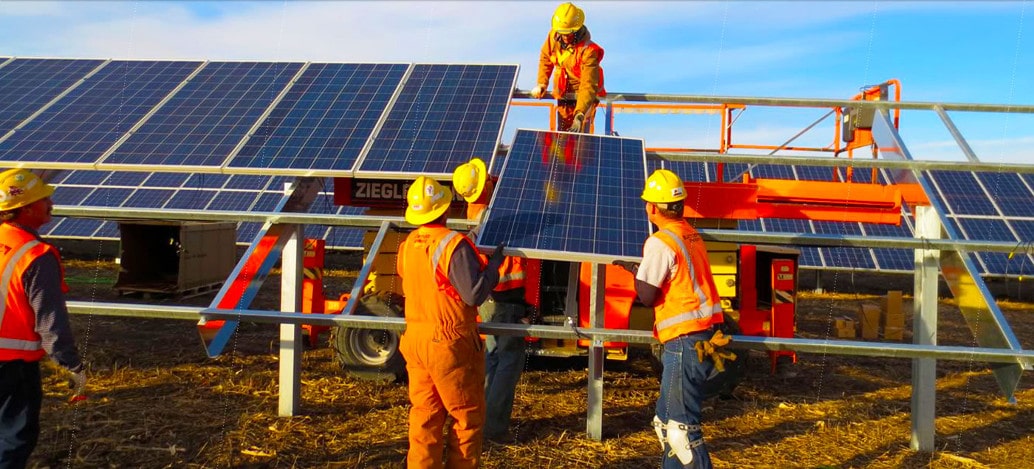In a matter of months, Covid-19 has wiped out an estimated 594,300 clean energy jobs in the United States — more than twice the number of new jobs the sector added to the economy in the past three years. A total of 850,000 clean energy job losses are now expected by the end of June.
These dire figures come from a new analysis on the pandemic’s impact on clean energy employment, released May 13 by Environmental Entrepreneurs (E2), E4TheFuture, the American Council on Renewable Energy (ACORE) and BW Research. To get people back to work, the leaders of these organizations are calling for immediate, targeted federal action, such as extending the year-end deadline for the solar investment tax credit (ITC), or deploying energy efficiency workers to upgrade thousands of now-closed schools.
“Right now, we are at an 18% jobless rate,” said Gregory Wetstone, CEO of ACORE, referring specifically to the renewable energy sector during a press call on May 13. “If this trend continues, we’re not far from a situation where one in every five renewable energy workers will have lost their jobs.”
Other key numbers from the report include:
- A total of 447,200 clean energy jobs were lost in April, with energy efficiency hardest hit at 310,200 jobs lost, followed by renewable energy generation at 71,800. Adding to the pain, the report includes an upward revision of clean energy job losses in March, from 106,400 to 147,100; it also does not include underemployed workers now on furlough or cut back to part time.
- Predictably, California had the highest number of clean energy jobs lost in April — 77,860 — but the losses in other states represented a higher percentage of unemployment in the sector. Job losses in Georgia — 25,251 — erased almost 30% of the state’s clean energy employment, while both Hawaii (3,372) and Kentucky (9,337) dropped close to a quarter of their clean energy jobs.
- Figures from the Bureau of Labor Statistics show higher unemployment rates for Hispanic-Latino clean energy workers compared to their historically low rates of participation in the sector as a whole. Hispanic-Latino employees make up 14% of the clean energy workforce, but an estimated 25% of job losses. The situation for women is marginally better; they account for 27% of clean energy jobs, but 19% of April job losses.
A mixed picture for solar
The April numbers do not break out detailed unemployment data for the solar industry, where anecdotal reports from the field are mixed. Information from the Solar Energy Industries Association (SEIA) shows individual installers and manufacturers laying off hundreds of employees, or being unable to move ahead with projects that would have employed hundreds.
Another speaker on the call, Dara Bortman of Exact Solar, an installer in Pennsylvania, said she has been able to keep employees paid, thanks to a loan from the federal Paycheck Protection Program. But, she is limiting her crews to certain kinds of jobs, mostly outside projects.
“My real concern,” Bortman said, “is that we’re probably going to lose about four to six months of real, solid installation time, and not be able to fully ramp [back up] due to people not ordering systems and delays with utility companies working remotely and more slowly on issuing permits and approving interconnection applications.”
Whether Congress will pass an ITC extension or any other support for clean energy jobs remains highly uncertain as additional proposals for economic relief are caught in election year politics.
But, in a bit of hopeful news for the beleaguered residential sector, a new survey from The Harris Poll for LG finds interest in residential solar up 13% amid pandemic lockdowns versus the 10% of people reconsidering a potential decision to go solar.
This content is protected by copyright and may not be reused. If you want to cooperate with us and would like to reuse some of our content, please contact: editors@pv-magazine.com.








Pretty much, it’s been left up to the States as to when people can ease away from social distancing, self isolation and self quarantine. I’m thinking the biggest problem is the number of tests and antibody tests out there, all have not been vetted and proven more effective than plus or minus 5 to 8% false positives or negatives. Need to find the most effective tests, get the workforce tested for the virus and for the antibodies. If antibodies are shown, put them back to work, if not, it is a personal decision and risk. Use face coverings at work sites and check temperatures for spikes, perhaps even several times a day on the work site.
The “leaders” will have to make it happen, the workforce deserves the best information it can get as to their personal risk of getting the virus or have they already been exposed to the virus and fought it off?
All construction starts and ends with government permitting and inspection. When government offices closed, no permits to start construction and no inspections to get payment from customers occured. Just as extream weather can stop construction, COVID-19 is a storm locking down the economy, but, the demand is just pent up. With wind and solar power becoming the least expecive choice along with battery storage prices comming down, we will see a resurgance with off grid backup in many areas that have suffered “black outs” like in California’s fire season. Local governments need the fees from permits so they will do everything they can to re-open when they can to get funds into the City coffers.